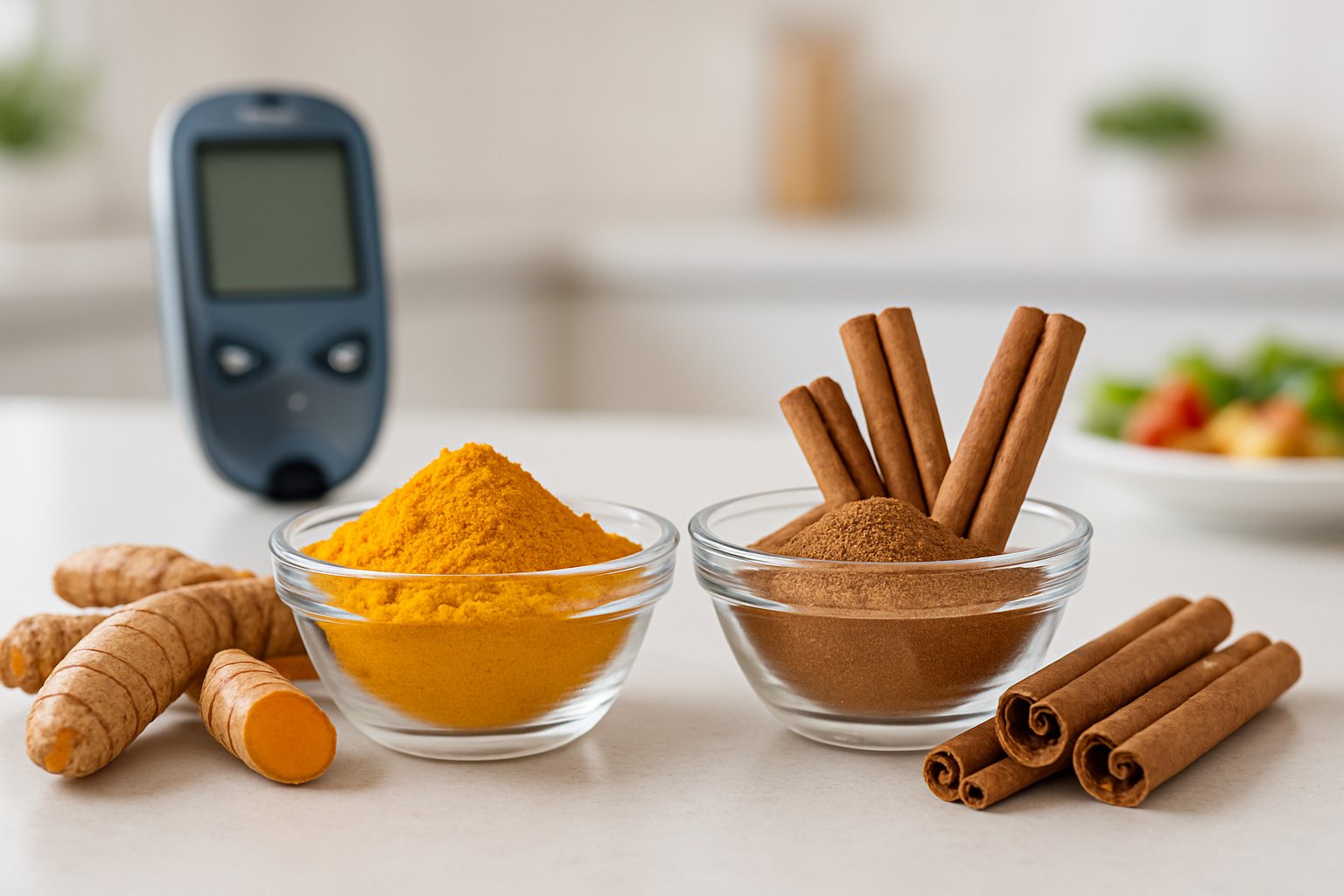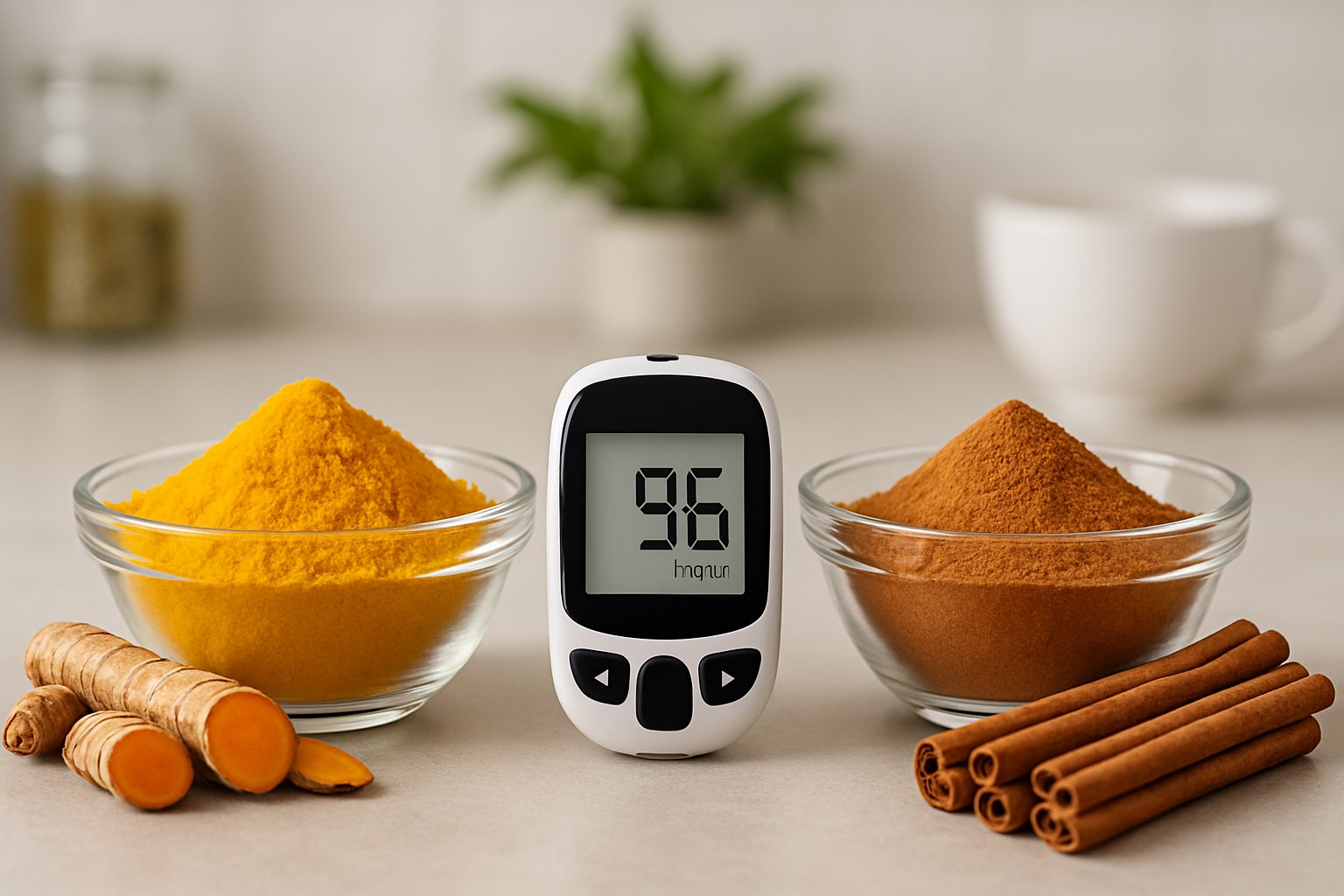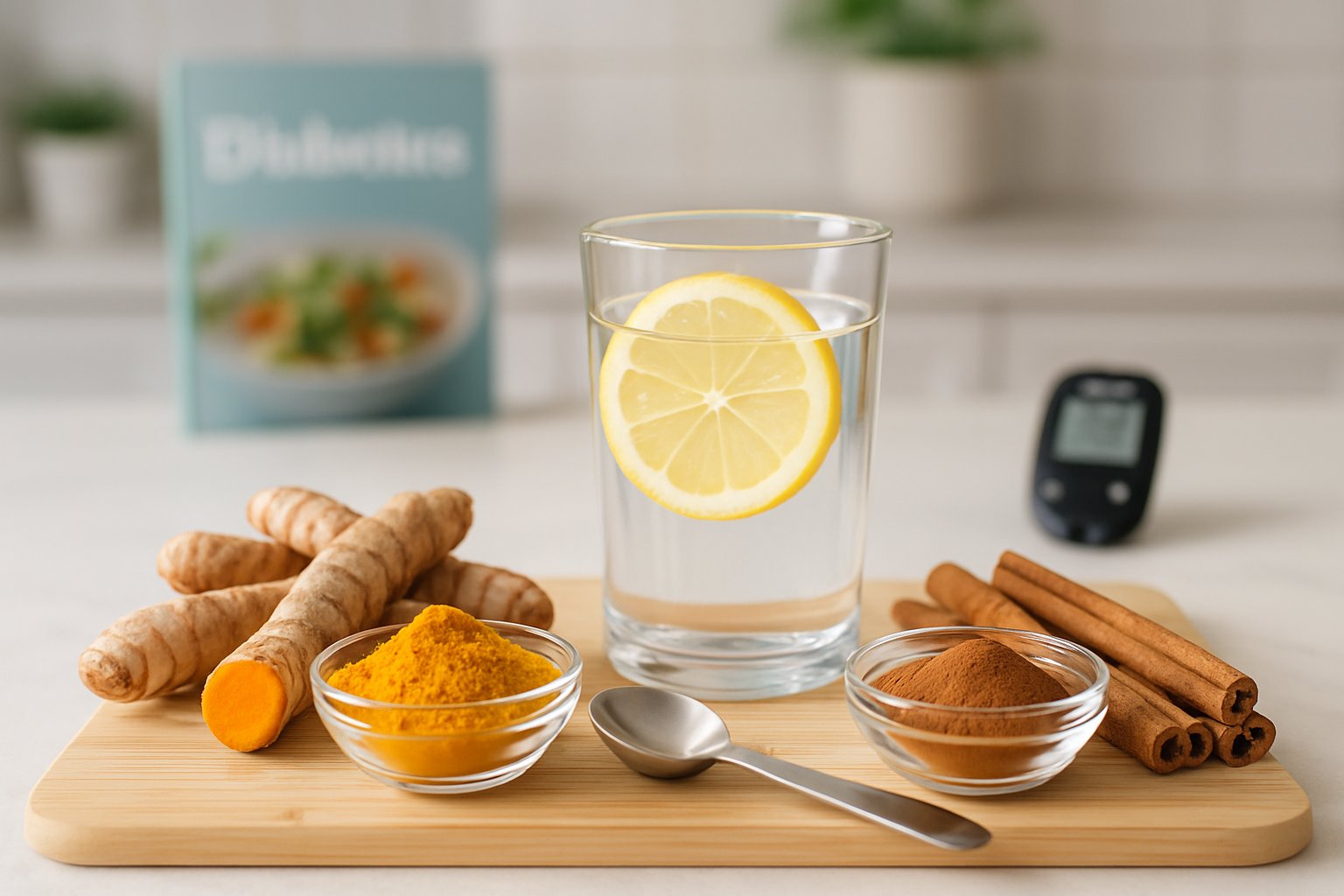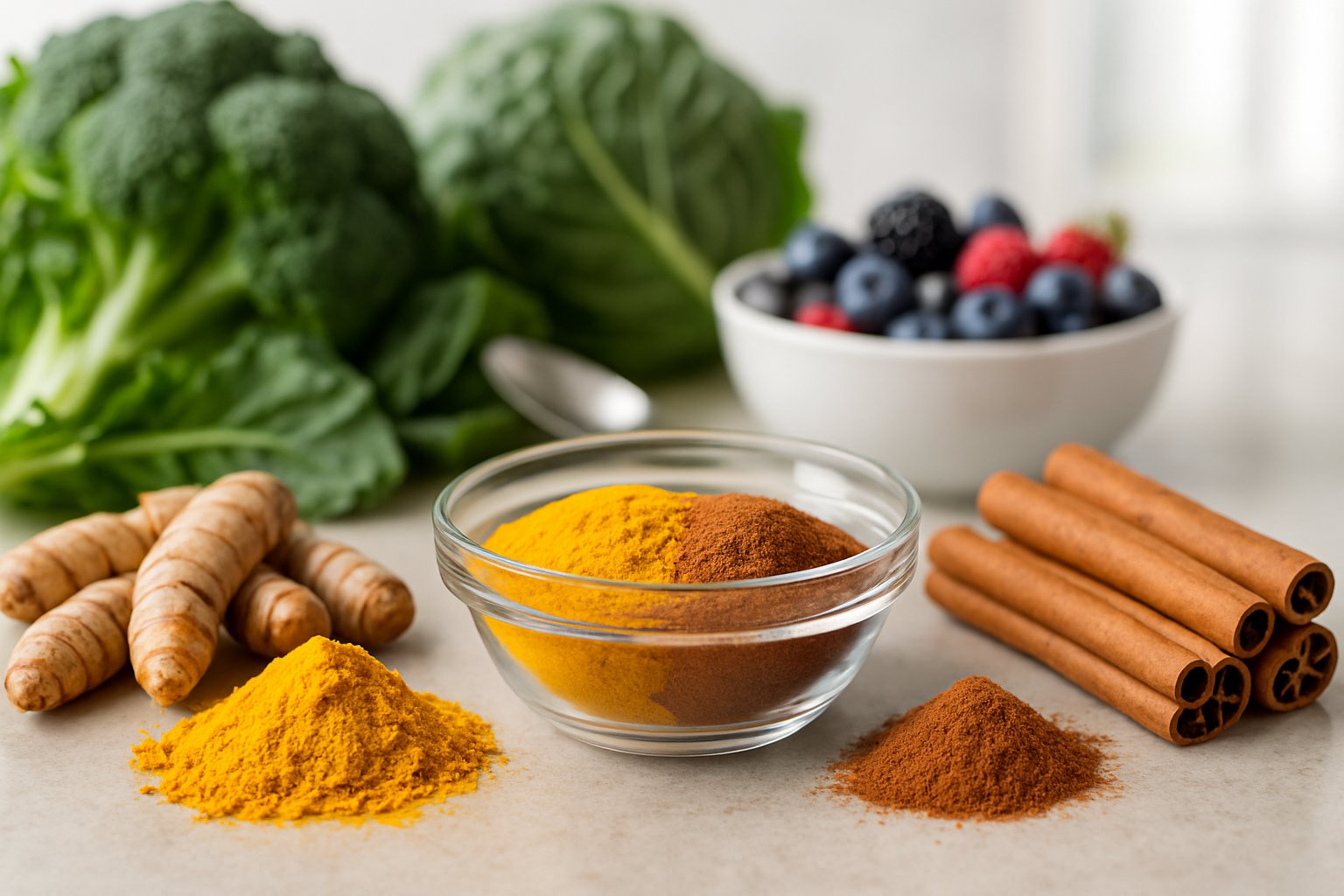Both turmeric and cinnamon can help lower blood sugar levels in people with diabetes. Cinnamon has stronger research support for diabetes management than turmeric. These spices work best as part of a complete diabetes management plan that includes proper diet and exercise.
People with diabetes often turn to natural spices to help manage their blood sugar levels. Two popular options are turmeric and cinnamon, both praised for their potential health benefits. But which one works better for diabetes management?

Recent research shows that both turmeric and cinnamon can help lower blood sugar levels, but cinnamon has more extensive clinical evidence supporting its use for diabetes management. Studies indicate that cinnamon significantly reduces fasting blood sugar levels[1] in people with type 2 diabetes. Turmeric also shows promise, with research demonstrating its ability to improve blood sugar control through its active compound curcumin.
The choice between these spices doesn’t have to be either-or. Both offer unique benefits and can be safely incorporated into a diabetes-friendly diet. Understanding how each spice works, their nutritional profiles, and proper usage can help people make informed decisions about adding them to their daily routine.
Comparing Turmeric and Cinnamon for Diabetes Management

Both spices work through different mechanisms to support blood sugar control, with cinnamon showing stronger direct effects on glucose levels while turmeric excels in reducing inflammation that drives insulin resistance.
Direct Impact on Blood Sugar Levels
Cinnamon demonstrates more pronounced effects on blood sugar levels compared to turmeric. The spice contains cinnamaldehyde and other compounds that mimic insulin by increasing glucose uptake in cells[2].
Studies show that just half a teaspoon of cinnamon daily can improve fasting blood glucose levels. The spice also slows carbohydrate digestion in the small intestine by blocking certain digestive enzymes.
Cinnamon’s blood sugar benefits:
- Reduces fasting glucose levels
- Slows carbohydrate absorption
- Prevents rapid blood sugar spikes
Turmeric has less direct impact on blood sugar levels. Its main compound, curcumin, works more on the underlying causes of diabetes rather than immediate glucose control.
The golden spice helps fat cells respond better to insulin signals. This improved cellular response leads to better glucose uptake over time.
Effects on Insulin Sensitivity and Resistance
Cinnamon improves insulin sensitivity, helping the body use insulin more effectively. The spice’s bioactive compounds make cells more responsive to insulin signals.
Regular cinnamon consumption can reduce insulin resistance in muscle and fat tissues. This means the body needs less insulin to move glucose from blood into cells.
Turmeric addresses insulin resistance through a different pathway. The curcumin in turmeric reduces inflammation that contributes to insulin resistance[2].
Key differences in insulin effects:
| Spice | Primary Mechanism | Timeline |
|---|---|---|
| Cinnamon | Directly improves insulin sensitivity | Weeks |
| Turmeric | Reduces inflammation causing resistance | Months |
Curcumin may also protect insulin-producing beta cells in the pancreas from damage. This protection could help preserve insulin production longer.
Anti-Inflammatory and Antioxidant Properties
Turmeric contains significantly higher antioxidant levels than cinnamon. Turmeric provides 584% more iron and 5 times more potassium than cinnamon[3].
The curcumin in turmeric has powerful anti-inflammatory properties. It decreases inflammatory markers in fat tissue and the liver, two key areas for glucose regulation.
Chronic inflammation plays a major role in diabetes progression. Turmeric’s anti-inflammatory effects address this root cause more effectively than cinnamon.
Cinnamon also has antioxidant properties but at lower levels. The spice helps reduce oxidative stress that damages blood vessels in people with diabetes.
Anti-inflammatory comparison:
- Turmeric: Strong anti-inflammatory effects, targets root causes
- Cinnamon: Moderate antioxidant effects, supports blood vessel health
Both spices work best when used consistently over time rather than in occasional large doses.
Nutritional Value, Usage, and Safety Considerations

Both turmeric and cinnamon offer unique nutritional benefits and require specific dosage guidelines for diabetes management. Understanding their nutritional profiles, proper usage amounts, and potential safety concerns helps people make informed decisions about incorporating these spices into their diabetes care routine.
Nutritional Profiles of Turmeric and Cinnamon
Turmeric provides several important nutrients beyond its active compound curcumin. One teaspoon of ground turmeric contains about 9 calories, 0.3 grams of protein, and small amounts of fiber, vitamin C, and manganese.
The spice also delivers iron, potassium, and magnesium in modest quantities. Turmeric’s bright yellow color comes from curcumin, which makes up about 2-8% of most turmeric powder.
Cinnamon offers a different nutritional profile with notable mineral content. One teaspoon of ground cinnamon provides approximately 6 calories, 2 grams of carbohydrates, and 1.4 grams of fiber.
The spice contains meaningful amounts of manganese, calcium, and iron. Cinnamon also provides antioxidants called polyphenols, which may support heart health and blood sugar control.
Key nutritional differences:
- Turmeric: Higher in curcumin, vitamin C, and protein
- Cinnamon: Higher in fiber, manganese, and calcium
- Both spices: Low in calories and rich in antioxidants
Usage Guidelines and Dosage Recommendations
Research studies typically use 1-6 grams of cinnamon daily for blood sugar benefits. This equals about 0.5-3 teaspoons of ground cinnamon per day.
People should start with smaller amounts like 0.5 teaspoons daily and gradually increase. Adding cinnamon to oatmeal, yogurt, or coffee provides easy ways to reach target amounts.
Turmeric dosage recommendations vary widely in studies. Most research uses 500-1000 mg of curcumin extract daily, which equals roughly 1-3 teaspoons of turmeric powder.
Absorption tip: Combining turmeric with black pepper increases curcumin absorption by up to 2000%. Just a pinch of black pepper with turmeric enhances its effectiveness.
People can add turmeric to curries, smoothies, or golden milk recipes. Unlike cumin, which has a different flavor profile, turmeric works well in both sweet and savory dishes.
Timing matters for fasting blood sugar benefits. Taking these spices with meals may help control post-meal blood sugar spikes better than consuming them on empty stomachs.
Safety, Interactions, and Choosing the Right Spice
Cassia cinnamon contains coumarin, a compound that may be harmful to the liver[4] in large amounts. Ceylon cinnamon has minimal coumarin content, making it safer for long-term use.
People taking blood-thinning medications should use caution with both spices. Turmeric and cinnamon can enhance the effects of anticoagulant drugs.
Diabetes medication interactions:
- Both spices may lower blood sugar
- Could increase risk of hypoglycemia
- Regular blood sugar monitoring becomes essential
- Medication adjustments may be necessary
Turmeric may cause stomach upset in some people, especially at higher doses. Starting with small amounts helps identify individual tolerance levels.
People with gallstones should avoid large amounts of turmeric. The spice can stimulate bile production and potentially worsen gallbladder problems.
For type 2 diabetes management, Ceylon cinnamon appears safer for daily use than cassia varieties. Turmeric with black pepper offers broader anti-inflammatory benefits that may support heart health alongside blood sugar control.
Both spices work best as part of comprehensive diabetes management rather than standalone treatments.
Frequently Asked Questions

People with diabetes often have specific questions about how cinnamon and turmeric work in their bodies. Understanding the proper dosages, potential side effects, and combination strategies helps diabetics make informed decisions about using these spices.
How does cinnamon affect blood sugar levels in diabetics?
Cinnamon contains compounds that mimic insulin by helping glucose move into cells more effectively. The spice improves insulin sensitivity[2], which means the body uses insulin more efficiently to process blood sugar.
The bioactive components cinnamaldehyde and proanthocyanidins are responsible for these blood sugar benefits. These compounds also slow down carbohydrate digestion in the small intestine.
This slower digestion prevents rapid blood sugar spikes after meals. Just half a teaspoon daily has shown promising results in clinical studies for improving fasting blood glucose levels.
What are the benefits of taking turmeric for people with diabetes?
Turmeric’s main active ingredient, curcumin, reduces chronic inflammation that contributes to insulin resistance. The compound decreases inflammatory markers in fat tissue and the liver[2], two areas crucial for blood sugar control.
Curcumin helps protect insulin-producing beta cells in the pancreas from damage. This protection may help preserve pancreatic function longer in people with diabetes.
The spice also makes fat cells more responsive to insulin signals. This improved cellular response leads to better glucose uptake throughout the body.
Can consuming turmeric help with diabetic neuropathy symptoms?
Turmeric’s anti-inflammatory properties may help reduce nerve inflammation associated with diabetic neuropathy. The antioxidant effects of curcumin can protect nerve cells from damage caused by high blood sugar levels.
Chronic inflammation plays a role in nerve damage progression in diabetics. By reducing this inflammation, turmeric may slow the development of neuropathy symptoms.
However, turmeric works best as a preventive measure rather than a treatment for existing nerve damage. People with established neuropathy should continue following their doctor’s treatment plan.
What is the recommended way to use turmeric for managing diabetes?
Fresh turmeric root provides the highest concentration of active compounds compared to dried powder. Combining turmeric with black pepper increases the absorption of curcumin by up to 2000%.
Adding a small amount of healthy fat like olive oil also improves curcumin absorption. The typical recommended dose ranges from 500mg to 1000mg of curcumin daily.
Turmeric can be added to eggs, roasted vegetables, soups, and smoothies. Taking it with meals reduces the risk of stomach upset that some people experience.
Are there any potential risks for diabetics when using turmeric supplements?
Turmeric can increase the risk of bleeding, especially in people taking blood thinners like warfarin. It may also interact with diabetes medications by potentially lowering blood sugar too much.
High doses of turmeric supplements can cause stomach irritation and nausea in some individuals. People with gallstones should avoid turmeric as it can worsen their condition.
Diabetics should monitor their blood sugar more closely when starting turmeric supplements. They should consult their healthcare provider before adding turmeric to their diabetes management routine.
Can a combination of ginger, turmeric, and cinnamon improve diabetes management?
Combining these three spices may provide multiple benefits for blood sugar control[2] through different mechanisms. Each spice targets different aspects of diabetes management.
Ginger enhances glucose uptake in muscle cells without requiring insulin. Turmeric reduces inflammation and improves insulin sensitivity. Cinnamon slows carbohydrate absorption and mimics insulin activity.
Using all three spices together in cooking or as supplements may create a synergistic effect. However, people should start with small amounts to assess their individual tolerance and response.
References
- cinnamon significantly reduces fasting blood sugar levels. https://www.eatingwell.com/best-spice-lower-blood-sugar-11697083 Accessed October 23, 2025
- How 5 everyday spices might ease type 2 diabetes symptoms. https://rollingout.com/2025/05/08/everyday-spices-ease-type-2-diabetes/ Accessed October 23, 2025
- Turmeric vs. Cinnamon — In-Depth Nutrition Comparison. https://foodstruct.com/compare/turmeric-vs-spices-cinnamon-ground Accessed October 23, 2025
- Which Cinnamon Is Better for Blood Sugar?. https://www.peoplespharmacy.com/articles/which-cinnamon-is-better-for-blood-sugar Accessed October 23, 2025
